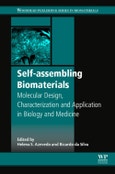Self-assembling biomaterials: molecular design, characterization and application in biology and medicine provides a comprehensive coverage on an emerging area of biomaterials science, spanning from conceptual designs to advanced characterization tools and applications of self-assembling biomaterials, and compiling the recent developments in the field.
Molecular self-assembly, the autonomous organization of molecules, is ubiquitous in living organisms and intrinsic to biological structures and function. Not surprisingly, the exciting field of engineering artificial self-assembling biomaterials often finds inspiration in Biology. More important, materials that self-assemble speak the language of life and can be designed to seamlessly integrate with the biological environment, offering unique engineering opportunities in bionanotechnology. The book is divided in five parts, comprising design of molecular building blocks for self-assembly; exclusive features of self-assembling biomaterials; specific methods and techniques to predict, investigate and characterize self-assembly and formed assemblies; different approaches for controlling self-assembly across multiple length scales and the nano/micro/macroscopic properties of biomaterials; diverse range of applications in biomedicine, including drug delivery, theranostics, cell culture and tissue regeneration.
Written by researchers working in self-assembling biomaterials, it addresses a specific need within the Biomaterials scientific community.
Please Note: This is an On Demand product, delivery may take up to 11 working days after payment has been received.
Table of Contents
1. Self-assembling biomaterials: beginnings and progress over the past decade
Part 1 Molecular building blocks for self-assembly 2. Designing peptides for self-assembling biomaterials with controlled mechanical and biological performance 3. Engineering silk fibroin for hydrogel self-assembly 4. Elastin-like proteins modular design for self-assembly 5. Sweet building blocks for self-assembling biomaterials with molecular recognition 6. Peptoid self-assembly and opportunities for biomaterials and biointerfaces 7. Lipid bolaamphiphiles for fabricating membrane-mimetic biomaterials 8. Self-assembling protein-DNA hybrid molecules as building blocks for complex biomaterials 9. Biomaterials based on ureido-pyrimidinone (UPy) and benzene-1,3,5-tricarboxamide (BTAs) supramolecular polymers 10. Self-assembling of biomaterials using host-guest chemistry
Part 2 Unique properties of self-assembling biomaterials: blurring the frontiers between biomaterials and biology 11. Adaptive supramolecular biomaterials through non-equilibrium self-assembly
Part 3 Nanoscale characterization of self-assembling biomaterials 12. Unveiling complex structure and dynamics in supramolecular biomaterials using super-resolution microscopy 13. Probing local molecular dynamics in self-assembling systems with electron paramagnetic resonance (EPR) spectroscopy 14. Small angle X-ray scattering (SAXS) to study spatial arrangement in self-assembled biomaterials 15. Studying nanoscale interactions in self-assembling systems through molecular simulations
Part 4 Mechanisms of self-assembly: controlling driving forces and boundaries for self-assembly across scales 16. Magnetic fields to align peptide assemblies and provide directionality in biomaterials 17. Using confined environments to control the shape and size of assemblies 18. Engineering dynamic self-assembling biomaterials at the interface 19. Enzymatic mediated self-assembly
Part 5 Applications of self-assembling biomaterials 20. Recreating stem cell niches using self-assembling biomaterials 21. Bioactive self-assembling scaffolds for regenerative medicine 22. Functionalization of self-assembling peptides for neural tissue engineering 23. Self-assembling biomaterials as nanocarriers for the targeted delivery of drugs for cancer 24. Self-assembling biomaterials for theranostic applications 25. Self-assembling artificial enzymes: biomaterial therapies for metabolic diseases








